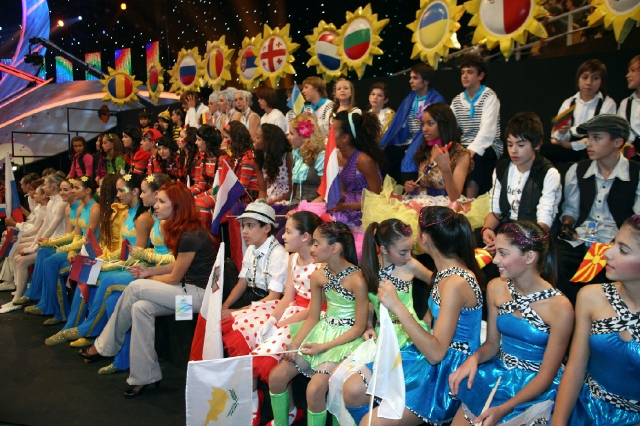The 50/50 Jury/Televote Split
Back in the 100% televote era of the main Contest, it was clear that relying entirely on public voting to produce a Eurovision winner had the potential to result in eye-catching but not always high quality winners, and that diasporic and cultural sympathies gave the appearance of neighbourly voting out of step with song quality. But how would a 50% jury/televote split work for a modern TV audience used to being in total control? Let’s test it at Junior!
In the 2008 edition of JESC, the 50/50 voting split was trialled before being rolled out for the 2009 edition of the adult contest. The voting scheme for JESC has been tweaked and altered over the years – the custom of giving a douze points to every competing nation at the start of the voting sequence started in 2005, the mixed age juries have variously been supplemented by a kids jury since 2012, pop experts including Jedward and latterly and with varying success, an online vote.
None of the more exotic changes to the voting system have as yet come to the main contest, but with increased interest in app and online voting in the various national finals, and in reality entertainment TV worldwide, it’s possible that the EBU will keep experimenting at Junior until a solution can be found that produces exciting, trustworthy and nationally-isolatable results.
The Green Room in the Venue
One of the joyous parts of the modern Song Contest is seeing artists reacting and celebrating in the Green Room during the broadcast. The first Eurovision show to try this was JESC 2005 in Hasselt, Belgium. The contestants were seated in a single area in front of the main audience, allowing the children to hang out during the performances and celebrate together during the voting. Pictured below is the Green Room area from the 2008 edition of JESC in Cyprus, showing all the performers together during a lull in proceedings.

This innovation came to adult Eurovision in Oslo 2010, where the delegations were housed in large matte black partial cylinders, which separated them visibly from the crowd. The in-venue Green Room designs have developed over the years, moving more towards the open, unifying area favoured by Junior, while still allowing delegations to have their own (potentially politically necessary) space.
The Flag Ceremony
The first Junior Eurovision Olympic style flag ceremony, which introduces the performers along with their national colours at the beginning of the broadcast, happened in 2004 and became a regular part of the format, allowing the audience welcome the children to the arena and helping viewers to strengthen the association of each performer with their home countries.

This came to the main contest in 2013, where the performers paraded across the representation of the Öresund Bridge suspended across the venue, accompanied by hosts carrying flags. In later years, we’ve seen exciting interpretations of the flag ceremony, with flags projected across a catwalk show and as splashes of CGI mist.
Near Misses
And some JESC innovations that haven’t been or won’t be successful at ESC…
- The joint song that works so well for the kids somehow didn’t take off when they tried it with the deeply awkward last chorus of Emmelie de Forest’s Rainmaker at Copenhagen 2014.
- Hashtags in official slogans. An attempt to catch the social media zeitgeist that will probably look dated more quickly than you’d expect.
- Awarding prizes to the 2nd and 3rd placed acts. At the main contest, a podium position is nice, but if your delegation’s goal was to win and host the contest, a trophy and a certificate isn’t much of a consolation to your broadcaster and your national tourism promotional body.
- Backing vocals on the backing track. At Junior, where the pressure of performance can be expected to take its toll on young voices, there is a bit more leeway for support from the backing track. But at the main contest, we recognise that we award points for superlative vocal performances and expect that to be carried through from the lead vocalist to the supporting vocals. Recent developments perhaps suggest that there may however, be a loophole.









